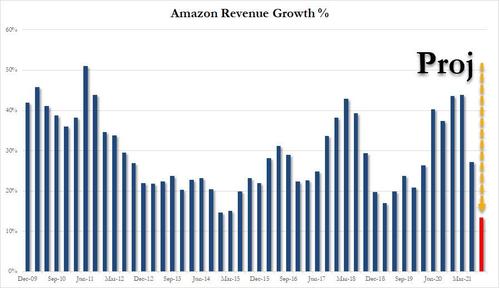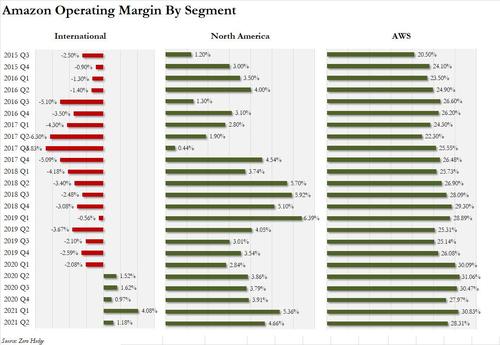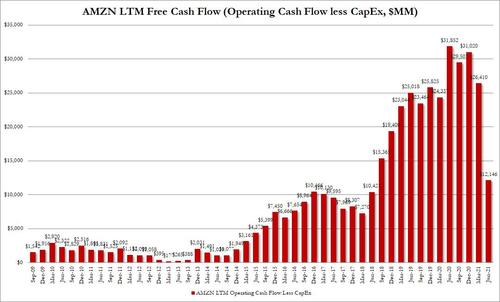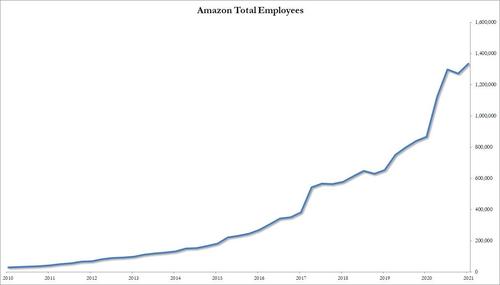...the bull already ended for many stocks but the major indices gave the illusion of strong stock market performance. But as I said, it ends when the monsters of tech story ends...
...Amazon's miss is a sign that their (monsters of tech) run should soon come to an expected end...then the indices roll over.
Amazon futures showing a 7.5% decline, Facebook already down 4% overnight is another 1.35% down, Apple off 0.89% Microsoft -0.68%, Alphabet -0.6%....plus the Chinese tech stocks that had their rebound...they are poised to turn back down again...Alibaba off the pace -1.29%, Baidu -1.83%.
Amazon Crashes After Missing Revenues, Guiding Far Below Consensus
BY Zero Hedge
THURSDAY, JUL 29, 2021 - 06:07 PM
With the bulk of the FAAM(N)G stocks reporting somewhat mixed earnings so far, with NFLX, FB, and AAPL disappointing offset by solid results from Google and Microsoft, investors were keenly looking for a tiebreaker from today's Amazon earnings, where the biggest question for Amazon is how sustainable are the growth trends that boosted its performance during the pandemic. The Internet giant was one of the biggest beneficiaries of shifts in consumer and business behavior last year while continuing to grab market share in cloud.
Many consumers flocked to buy things online as they wanted to avoid infection at physical stores. Further, Amazon Web Services revenue soared on back of rising usage from Internet digital services - including remote-working software, videostreaming and gaming. But with the wider available of vaccines and as employees start to return to physical offices, the risk is some of these trends may start to reverse. Bloomberg also notes that investors will be also looking for any commentary on the future prospects for regulation and antitrust legislation.
Questions aside, Amazon shares - which spent much of 2021 in a tight range - rallied in recent weeks, rising from $3500 to just over $3700 before giving up half the gains in the past few days. The stock has been approaching an intraday record of $3,773.08 that was set in early July, although so far it has been unable to surmount it.
Looking ahead, Amazon - in its first quarter under new CEO Andy Jassy who may or may not join the analyst call later today, as a reminder Jeff Bezos hadn't joined an earnings call since 2009 - is expected to post revenue of $115 billion, up 29% from a year earlier, with EPS of $12.28, up 19%. Both would be records for the second quarter. Looking at Amazon's cash machine, analysts expect AWS to pull in $14.1 billion in the second quarter, up 31% from a year earlier. The unit’s growth has slowed in recent years, and lags that of smaller cloud-computing rivals Microsoft and Google.
As Bloomberg notes, a forward-looking question for today: How is Amazon’s profitability going to shake out after the company added millions of customers, hundreds of warehouses, and hundreds of thousands of employees in the past year?
* * *
So with that in mind, how did Amazon do in Andy Jassy's first quarter as the company's new CEO? Well... not so good: not only did the company miss on the top line and operating income, but guided much lower than Wall Street expected
Looking ahead, the company's guidance was unexpectedly ugly, with the high end of expectations missing sellside consensus
- Net Sales $113.1B, up 27 Y/Y but badly missing estimates of $115.1B
- EPS $15.12, beating estimates of $12.28
- Operating Income $7.7BN, missing est. $7.82B
- AWS net sales $14.81 billion, up 37% and beating estimate $14.18 billion
- Online stores net sales $53.16 billion, missing estimates $56.71 billion
- Free cash flow plunged 62% to just $12.146 billion, well below consensus expectations.
Commenting on the results, Amazon's new CEO Andy Jassy said that “over the past 18 months, our consumer business has been called on to deliver an unprecedented number of items, including PPE, food, and other products that helped communities around the world cope with the difficult circumstances of the pandemic. At the same time, AWS has helped so many businesses and governments maintain business continuity, and we’ve seen AWS growth reaccelerate as more companies bring forward plans to transform their businesses and move to the cloud."
- Q3 Net Sales $106.0B to $112.0B, badly missing Wall Street est. $118.75B
- Q3 Operating income between $2.5 billion and $6.0 billion, also missing estimates of $8.11BN
Digging into the numbers we find that the company's revenue grew by 27% in Q2, well below the 45.0%. it gets worse because the Q2 midline revenue of $109BN is projected to grow just 13.4% Y/Y, the slowest growth in the past decade.
Asked during the analyst call whether Amazon’s dour third-quarter forecast is driven by the worrying growth of coronavirus cases and the delta variant, CFO Olsavsky said not specifically; instead Amazon expects shoppers to remain out and about. Olsavsky also pleaded tough comps to last year: while in 2020, the pandemic was accelerating this year, people are getting out and about, and not doing so much online shopping. As a result, Olsavsky says relatively slower growth versus last year’s numbers will continue “for the next few quarters.”
There was more bad news: operating margins slipped, dropping from 8.2% in Q1, which was the the highest in recent history, to a far more modest 6.8%
A look at margins alsoshowed a unpleasant drop in both North American and Intl retail margins, while the AWS margin of just over 28.3% was one of the lowest since the start of the covid pandemic, raising investor concerns that margins may have peaked.
The silver lining is that at least AWS sales picked up materially, rising 37% Y/Y to 14.8%, beating estimates.
Some more good news: Amazon’s brick-and-mortar arm is growing again, a sign of the return to in-store shopping as the pandemic recedes in parts of the U.S. Sales in the physical stores category, mostly Whole Foods Market, rose 11% to $4.1 billion, although that is just 4% of Amazon’s total revenue,
However, this improvement was more than offset by growth in online stores which slowed significantly to just 16%, the lowest since 2019, generating only $53.16 billion in sales, badly missing estimates of $56.71 billion
Furthermore, in even more evidence that shoppers are returning to stores and doing less browsing on Amazon.com: Unit sales - the old-school measure of how many items Amazon sold in the quarter - were up just 15% in the second quarter. That’s the slowest growth rate since early 2019. Unit-sales growth during the previous four quarters, with plenty of pandemic lockdown shopping, averaged 48%.
Amazon's total Free cash flow (including leases and obligations) was another ugly mark, tumbling more than 62% Y/Y to just $12.146 billion for the trailing twelve months.
One place where all this cash went is capital spending: purchases of property and equipment totaled $26.3 billion during the first six months of 2021, nearly doubling the prior-year total to that point. That cash is going to purchase plenty more warehouses and AWS data centers. And while such investments have traditionally paid off, Amazon’s spending sprees could rattle investors if the view is the company is funneling most of its cash back into the business.
Despite the ugly results, the company resumed its hiring ways and after a small dip in Q1, the company employees hit a new record high of 1.335 million.
Commenting on the results, Bloomberg's Kriti Gupta writes that if only hitting the analyst estimates is a negative for the megacap tech stocks, then missing them will be a disaster and one look at AMZN stock after hours confirms this. As Gupta muses rhetorically, could this be the end of the pandemic-related spending boom?
This morning’s economic data suggested consumer spending was still roaring, but the early takeaway from Amazon suggests perhaps that could also come to an end. Note, this company also has a massive shipping and distribution network that in the depths of the pandemic didn’t end up being profitable, but rather a weight.
For now investors are skeptical that AMZN will find a new tailwind and have sent its stock plunging more than 5%, crashing more than $200 lower to just under $3,400.
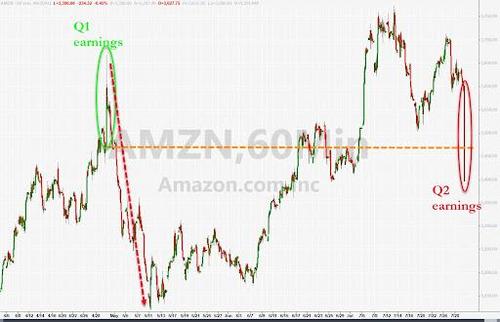
- Forums
- ASX - General
- Its Over
...the bull already ended for many stocks but the major indices...
- There are more pages in this discussion • 11,704 more messages in this thread...
You’re viewing a single post only. To view the entire thread just sign in or Join Now (FREE)
